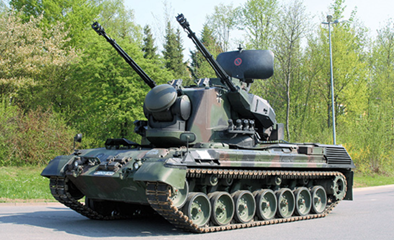Background
The Gepard (cheetah) Self-Ppropelled Anti-Aircraft Gun (SPAAG) was developed in the 1960s as a private venture. First prototypes were built in 1968. It entered service with the Bundeswehr in 1973 as the Flakpanzer-1 Gepard. A total of 420 of these vehicles were built for the German Army. Its role is to protect combat units, troops and key installations against air attacks. The Gepard is currently in service with Germany, Brazil, Chile, Jordan, Romania and the Netherlands.
Ammunition load of the Gepard consists of 640 armor-piercing-incendiary rounds for firing against air targets and 40 armor-piercing rounds against ground targets.
General search radar is located at the rear of the turret roof and tracking radar is located between the guns. Vehicle is fitted with friend-or-foe identification system. Radar of the Gepard has a range of 15 km. It provides all-round scanning with simultaneous target tracking. Vehicle has search on the move capability. This SPAAG is also fitted with fire control system.
Hull of the Gepard provides protection against small caliber cannons, while turret protection is only against small arms fire and artillery shell splinters. It is also fitted with NBC protection system.
The Gepard crew consists of three members: commander, gunner and driver.
Vehicle is based on the chassis of the Leopard 1 main battle tank. It is powered by the MTU MB Ca M500 diesel engine, developing 830 horsepower. The Gepard is fitted with auxiliary power unit, which powers all systems when the main engine is turned off. Engine and transmission of the Gepard can be replaced in 20 minutes in field conditions.
